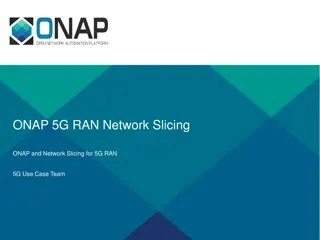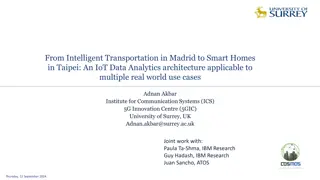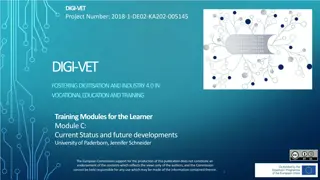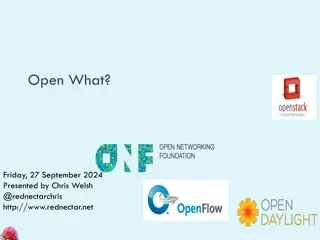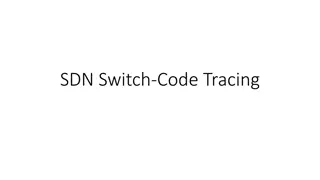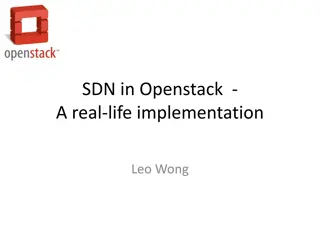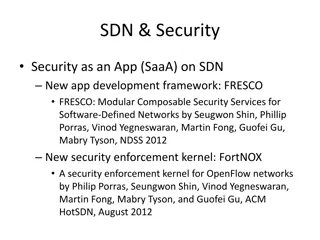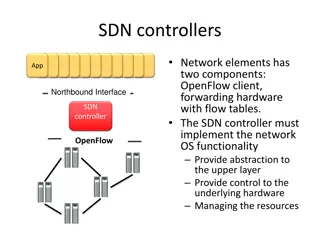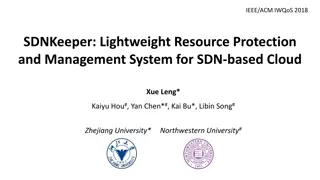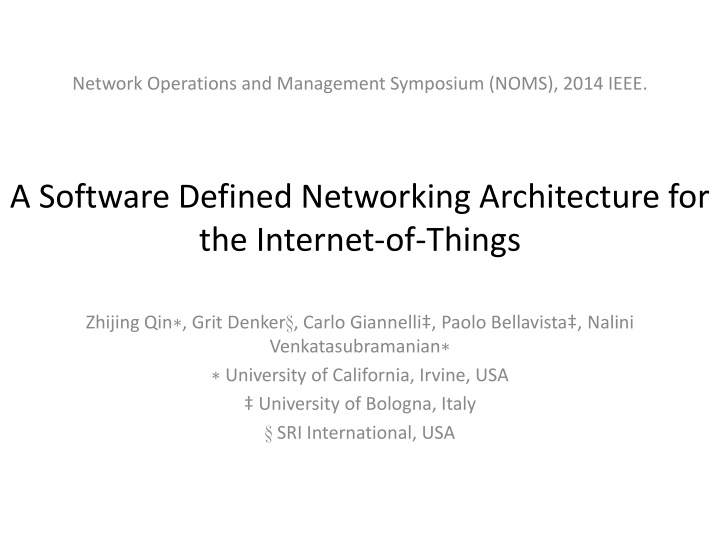
Software Defined Networking Architecture for IoT Challenges and Solutions
Explore the challenges and solutions in IoT deployments, focusing on a novel multi-network controller, modified Network Calculus for IoT modeling, and a QoS flow scheduling algorithm. The architecture, resource matching, and flow scheduling aspects are detailed with a network calculus-based model.
Download Presentation

Please find below an Image/Link to download the presentation.
The content on the website is provided AS IS for your information and personal use only. It may not be sold, licensed, or shared on other websites without obtaining consent from the author. If you encounter any issues during the download, it is possible that the publisher has removed the file from their server.
You are allowed to download the files provided on this website for personal or commercial use, subject to the condition that they are used lawfully. All files are the property of their respective owners.
The content on the website is provided AS IS for your information and personal use only. It may not be sold, licensed, or shared on other websites without obtaining consent from the author.
E N D
Presentation Transcript
Network Operations and Management Symposium (NOMS), 2014 IEEE. A Software Defined Networking Architecture for the Internet-of-Things Zhijing Qin , Grit Denker , Carlo Giannelli , Paolo Bellavista , Nalini Venkatasubramanian University of California, Irvine, USA University of Bologna, Italy SRI International, USA
2 Introduction The IoT scenarios give rise to many technical and organizational challenges Real world IoT deployments are characterized by very heterogeneous devices and connectivity capabilities New challenges are introduced Shared provisioning of network and sensor resources across apps Interoperability challenge of the heterogeneous applications and devices Contribution of this paper Propose a novel IoT multi-network controller Introduce and modify the Network Calculus to model IoT multi-network Propose a multiple-QoS-constraints flow scheduling algorithm
3 Controller Architecture Fig. 1 shows the controller architecture Admin/Analyst API enables control processes by humans or external programs Fig. 2 shows the layered view Hide details of lower layers so that tasks can be accomplished in a more flexible way Separate abstraction levels allow dedicated algorithms for a certain layer
4 Resource Matching A bridge between high level task descriptions and low level resource specifications is needed Employ a semantic modelling approach to provide such bridge Describe characteristics and capabilities of network and device resources and services Describe IoT tasks as hierarchical semantic tasks descriptions Example: a generic task description for LocateAndTrack(Vehicle, Location)
Flow Scheduling 5 - Network Calculus-Based Model Network Calculus [23] is a technique dealing with queueing type problems in modern packet-switched computer networks Focus on performance guarantees, modeling arrival traffic, service capability, and departure traffic as curves [23] J.-Y. Le Boudec and P. Thiran, Network calculus: a theory of deterministic queuing systems for the internet. Springer, 2001, vol. 2050.
Flow Scheduling 6 - Network Calculus-Based Model (Cont.) Assume each node has constant capacity ? and can provide a service curve ? ? = ?[? ?]+ as Fig. 3 ? is the transmission delay, which depends on ?, the length of the packet, and the amount of data in front of this packet when it hits the queue Use min-plus convolution on arrival and service curves to generate a departure curve: which means
Flow Scheduling 7 - Network Calculus-Based Model (Cont.) Two properties enabling Network Calculus to model multiple flows in complex networks If there s more than one flow going through a node, all flows share the same transmission service In a multi-hop path, the departure curve of current hop is the arrival curve of the next hop as in Fig. 5 Modify classic Network Calculus by examining the traffic as a set of discrete points, where each point represents a packet
Flow Scheduling 8 - Network Calculus-Based Model (Cont.) Define jitter as the difference between two successive packet arrival intervals Once get arrival curve D(t) of flow i at destination node by the modified Network Calculus model, compare it with flow i s initial arrival curve A(t) Each packet suffers from a delay and have a final arrival time Validation: Two-hop network Qualnet simulator Average error rate of delay, jitter, and throughput are 0.05, 0.08, and 0.03
GA-Based Multi Constraints Flow Scheduling 9 A communication path in a network perfectly matches with the chromosome concept in GAs Nodes are the genes Mutation and crossover can be done by replacing a sub-path and exchanging sub-paths between two paths Fitness value is the QoS performance of the flow going through this path Many GA-based routing protocols with multiple QoS constraints have been proposed [28], [29], [30], but this paper makes the following key contributions Take the inter flow interference into consideration Schedule the flows over links with different capacity [28] R. Leela et al., Multi-constraint qos unicast routing using genetic algorithm, Appl. Soft Comput., vol. 11, no. 2, Mar. 2011. [29] F. Xiang et al., Qos routing based on genetic algorithm, Computer Communications, vol. 22, no. 1516, pp. 1392 1399, 1999. [30] A. Koyama et al. A ga-based multi-purpose optimization algorithm for qos routing, in Advanced Information Networking and Applications, 2004.
GA-Based Multi Constraints Flow Scheduling (Cont.) 10 Problem statement Given a directed graph ? < ?,? >, each link (?,?) ? has a capacity ??,? ? is the set of flows and each flow ?? ? has several parameters: source ?, destination ?, start time ?0, and arrival curve ??(?) Each flow has a QoS requirements vector ??=< ??,??,??> The problem is to find a path ? from source node to destination node for each flow, such that: Data structures and procedures: chromosome structure and Initialization A chromosome represents a path Each flow ??eventually has one chromosome Two initial chromosomes for each flow are set by using Dijkstra s algorithm
GA-Based Multi Constraints Flow Scheduling (Cont.) 11 Fitness Value Crossover choose the most two top ranked chromosomes with common genes as the parents E.g., use (s, a, b, c, d) and (s, e, b, d) to generate two children (s, a, b, d) and (s, e, b, c, d) Mutation Given a path s,a,b,c,d, choose a bottleneck node, say b Among the neighbors of its last hop, node a, randomly choose another node x which can reach destination d => get mutation path s, a, x, , d
GA-Based Multi Constraints Flow Scheduling (Cont.) 12 Acceptance and Replacement The top two chromosomes of the output of mutation will replace the current two chromosome parents New parents will be the input of the Crossover procedure for the next iteration Termination The algorithm iteratively runs until each flow has a feasible path (with fitness value 0) or the predefined generation size is achieved
13 Experiment Setup Implement the prototype of the proposed controller using Qualnet simulation platform [31] Customized Qualnet with SDN features by injecting an OpenFlow-like protocol in IP layer [31] Scalable networks technologies http://www.scalable-networks.com.
14 Experiment Setup (Cont.) Compare GA-based flow scheduling with two common scheduling algorithms used in SDN world Bin packing: tries to maximize the link utilization Load balancing: let total amount of the flows is proportional to the capacity of the link Exploit a real deployed smart campus network topology [32] Vehicles with wireless connectivity exploit either LTE or WiFi road side units to receive data from servers Consist of 3 data servers, 3 edge switches, 2 core routers, and 15 APs with 45 end devices Three types of APs: WiFi, Femtocell, and Bluetooth [32] UC Berkeley campus network maps. [Online]. Available: http://net.berkeley.edu/netinfo/newmaps/
15 Experiment Setup (Cont.) Each of the three data servers provides either file sharing, tele audio, or video streaming services File sharing flows are modeled by sending Constant Bit Rate with packet length uniformly distributed in [100, 1000] bytes with period T Tele audio and video streaming flows are from real traffic traces [26, 27] [26] Video streaming trace files. [Online]. Available: http://trace.eas.asu.edu/TRACE/ltvt.html [27] Skype tele audio trace files. [Online]. Available: http://tstat.polito.it/traces-skype.shtml
16 Experiment Procedure In GA-based algorithm, initially choose two paths for each flow as parents Services have different QoS requirements File sharing service requires large throughput Tele audio service requires low delay Video streaming service requires low jitter Instead of setting particular QoS requirement in the simulation, the authors try to optimize QoS performance in a predefined amount of generations (set 10 here) Changes in equation and the parameters File Sharing 0 0 1 10000 ?? Fitness value: ???+ ??+ ? Tele Audio 1 0 0 Video Streaming 0 1 0
17 Evaluation Results
18 Evaluation Results (Cont.)
19 Conclusion This paper presented an SDN controller design in IoT Multinetworks Gave a vision on tasks and resources in IoT environments Illustrated how to bridge the gap between abstract high level tasks and specific low level network/device resources Developed a variant of Network Calculus to estimate the end-to- end flow performance Simulation has shown that the proposed flow scheduling algorithm has better performance compared with existing ones Currently in the process of integrating the layered controller design with the MINA software stack




